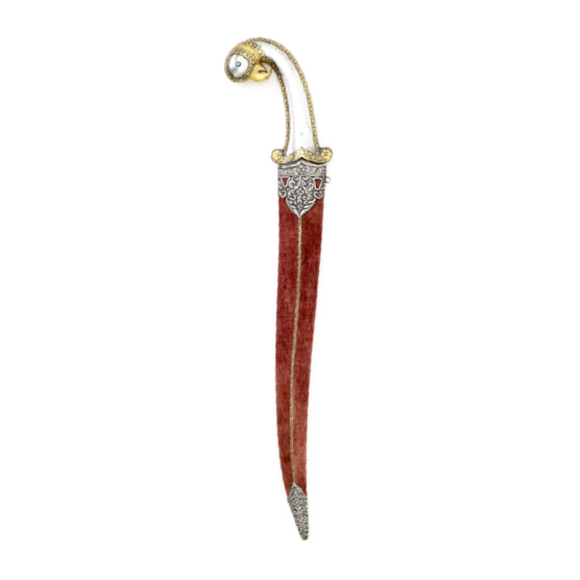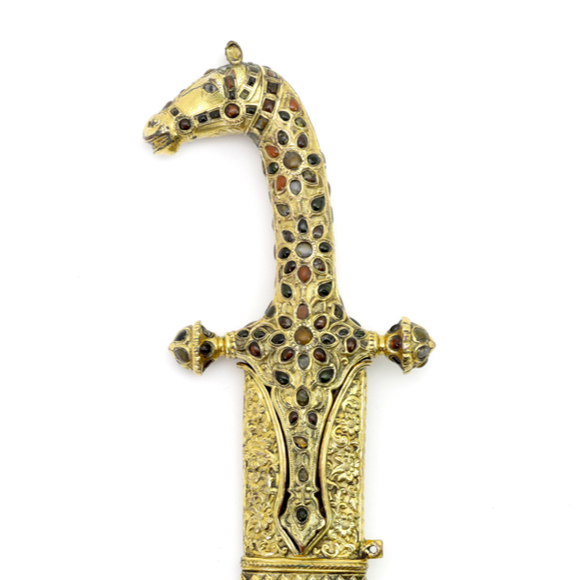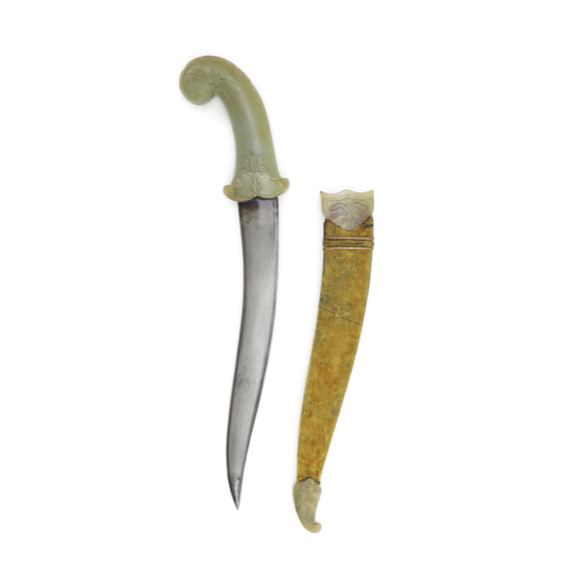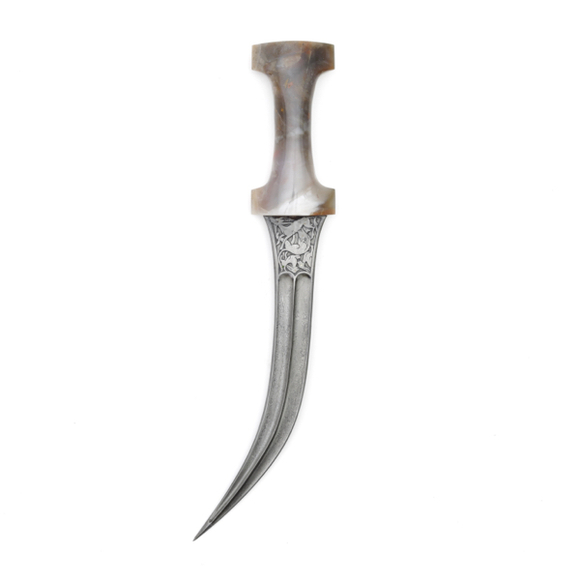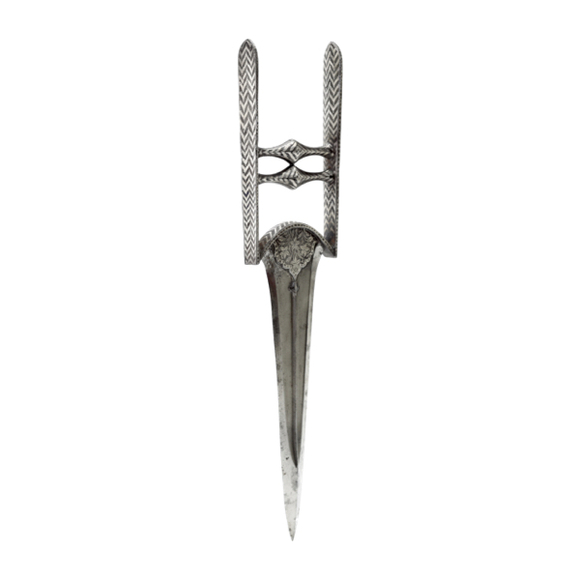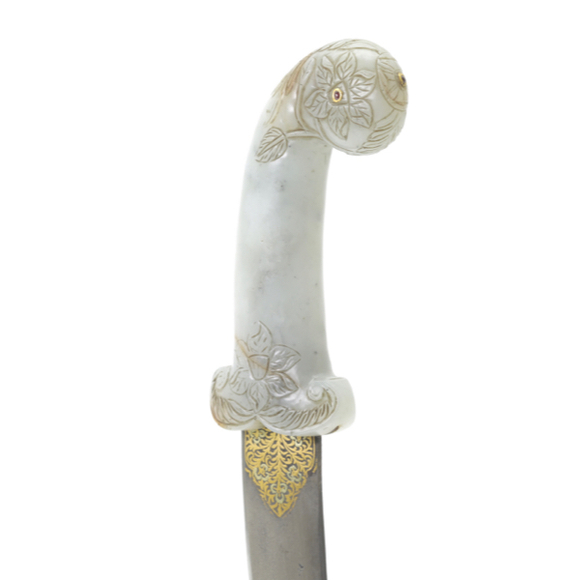With vintage silver mounted scabbard.

Sheathed 34.9 cm
Katar 31.5 cm
15.3 cm
Base 3 mm
Thickening at tip 8 mm
Base 69 mm
Thickening at tip 27 mm
353 grams
4 mm into hilt
Iron, steel, silver, leather, silk, cotton, enamel.
Central Deccan
(Bijapur Sultanate to Mughal)
Late 17th centuy
Description
A charming Indian katar. The blade is of northern form featuring a wide, short blade with ridged sunken panels with a raised central rib and V-shapes raised areas. It is made of a fine-grained Indian wootz. The edges are burnished bright in northern fashion, nicely contrasting the center wootz panel.
The hilt features handlebars with a peaked center and a slightly domed base for the blade. The bars are mainly associated with the north, but the domed base of the blade refers to southern influence.
The most striking aspect of this katar is the tasteful decoration by means of true inlay. It differs from the more usually seen overlay in that it was applied in channels cut deeply into the metal, in which gold or in this case silver was inserted. True inlay is a lot more labor-intensive but also much more durable than overlay.
The decor, in this case, consists of a pattern of stylized lotuses, done in silver which was ground flush with the surface. The steel hilt was patinated a deep dark blue to make the silver stand out.
Scabbard
It comes with its original scabbard, made of leather and covered with silk brocade with a pattern of flowers, now largely worn. It is decorated on the front with a green cord and metallic wire braid. It further has a silver chape with multi-color enamel work of a style that especially Lucknow was famous for.
Condition
In good condition for age. Blade with usual signs of age and some pitting. Edge contours largely intact. Inlays in a good state of preservation for age, with some losses here and there. Scabbard in old, worn condition with fraying to the sides. Leather core still structurally sound. Chape with losses to the enamel, and minus the protruding top part on one side.
Dating & attribution
A katar of nearly identical form was published in Robert Elgood; Rajput Arms & Armour. It also has the somewhat unusual combination of peaked, northern style handle bars with a domed, more southern style base. He attributed it to Bijapur, the Deccan, late 17th century.1
Although the blade shows typical northern features, the decorative work does indeed remind strongly of the designs and also aesthetics of Bidri wares, made in Bidar, near Hyderabad in the Deccan. The Bidar Sultanate was annexed by the Bijapur Sultanate in 1619, and the Bijapur Sultanate was in turn annexed by the Mughal Empire in 1686.
According to Hendley, the combination of blueing and flower motifs in true inlay was an earlier feature:
"The visitor to the Indian Section of the South Kensington Museum will find good specimens of both forms of the work. He will see how very superior the old examples are to the modern ones. In the former the best results are attained with the simplest designs, which are displayed on an ample ground of blue steel. In the latter, even at the best, the work is spoiled by an excess of meaningless and elaborate scroll, floral, or arabesque ornament done in fine instead of bold lines." 2
-Thomas Holbein Hendley, 1883
"The older pieces (17th century) are decorated with large flowers or birds in silver damascene work." 3
-Herman Goetz, 1950
Conclusion
A charming early katar with tasteful decor in inlaid silver. The piece exhibits an interesting mix of styles that combine a more northern Indian design with some southern features. The piece dates almost certainly from the late 17th century and is possibly from the Bijapur Sultanate. The scabbard is possibly somewhat later, probably dating from the 18th or 19th century.
Notes
1. Robert Elgood; Rajput Arms & Armour, Niyogi Books, New Delhi, 2017. Volume 1
2. Thomas Holbein Hendley; Damascening on steel or iron as practiced in India. W. Griggs & Sons, Ltd. London 1892.
3. Hermann Goetz; The Art and Architecture of Bikaner State. Bruno Cassirer, Oxford. 1950. Page 124 - 125.





























The style typical of Kutch, the execution far above what is normally seen on work from that area.
Nice and complete with opaque green hilt and scabbard mounts.
Nice Persian dagger with fine wootz blade and unusual hilt material.

